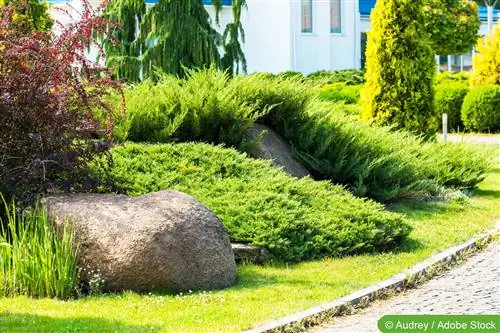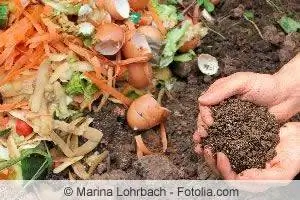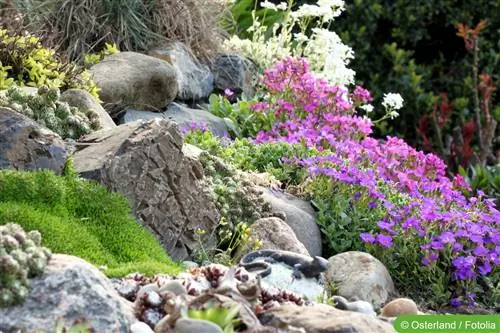- Author admin [email protected].
- Public 2023-12-17 03:39.
- Last modified 2025-06-01 06:48.
Stone is not only used in the well-known Japanese rock gardens to design and structure gardens. If you want to use this effect in your own garden, you should think about using boulders in the garden. With their diverse design, these can capture the visitor's gaze, especially in large gardens and wide areas, and have a lasting influence on the visual design of the green area.
Integrating boulders into the garden
If the gardener now wants to integrate various boulders into his own garden, he must first think about the placement of the boulders. These can either be incorporated directly into the bed design by serving as a border between beds, or positioned in the middle of a lawn to visually break up these areas and attract the viewer's eye. In any case, it is important that the surface for the boulders is prepared accordingly. Since these stones not only have a certain size but also a considerable weight, it should be avoided that they are pressed too deeply into the ground. To do this, the subsoil where the stone is supported should be excavated beforehand and compacted with gravel. On the one hand, this prevents the boulders from sinking into the ground and, on the other hand, prevents grass or weeds from growing underneath the boulders.
Boulders can therefore be used to
- to structure large areas
- Focusing the viewer's attention on specific areas of the garden
- Changing the mood of certain garden areas
- Achieve a rustic look
- Set color contrasts
Stage boulders
If you want to incorporate a boulder into your own garden design, it should usually serve as a design element of the garden. Accordingly, it makes sense to choose the most prominent places in the garden for the boulder. Near the terrace or the pond, for example, such boulders can create a very natural and grown impression and thus give the garden a natural cosiness. To do this, however, it is necessary to adapt the boulder to the rest of the garden's design. The material should either match the other stone elements used in the garden, or stand out from them very clearly in terms of color and texture. If the garden is designed primarily with white pebbles, a very dark boulder is ideal, for example. In this case you can, for example, place it on a bed of large, white pebbles to further enhance the visual effect of the boulder.
But a boulder can also be easily incorporated into the garden design in combination with colorful flowering plants. As the centerpiece of a round bed, for example, the boulder can be surrounded by a variety of flowers and provides a monochrome background for the blooming flowers in the bed in front of it.
Enchanted herb garden with boulders
But the shady areas of the garden, which are often used for herbs and crops, can also be made more attractive with a boulder. It would be an advantage if the boulder could be overgrown by individual plants. A stone “enchanted” in this way makes the garden appear very old and natural and ensures a much stronger effect on the actually mundane herb bed. However, you should make sure that the stone is overgrown, but that no plants are attached to it. Traces of climbing plants in particular can hardly be removed from the boulder later.
Rustic Garden Shed
But garden sheds can also be made more attractive with boulders. Especially with a hut made of wood, the use of boulders around the hut can significantly reinforce the impression of the same. However, it is important that the hut itself is made of natural materials. Wood and stone complement each other and give this garden area an almost antique look.
The use of boulders depends primarily on the size of the garden and the associated possibilities. The larger the garden, the larger and more striking the boulders can be chosen. Small gardens, on the other hand, would be almost overwhelmed by a large boulder and would lose a lot of their usable space. The use of smaller boulders, which can create subtle accents, is more advisable here. Using different materials and boulders in different colors, you can create special accents and eye-catchers that also look great in smaller gardens.
Pebbles have always been popular collectors and exchange items
Even children are happy when they find beautifully patterned specimens or even ones with a hole while walking by the sea or river. It's best to start collecting again. With us you will find suggestions for what you can do with the boulders. If you don't want to go collecting yourself, you can buy bags of sorted pebbles at hardware stores.
Then you can get started.
Make your own pebble slab from boulders
For a pebble slab, the size of the slab should be determined precisely in advance. The frame is then built accordingly large from wooden strips. In order not to endanger the stability of the plate, the plate should not be larger than 35x35 cm. The thickness should be 4 cm.
Instructions
Ingredients: wooden slats, nails, hammer, cement, plastic bowl, rubber gloves, plastic sheet, pebbles, cardboard, meter rule
Prepare
Draw the size of the plate (approx. 30×30 cm) on a piece of cardboard and lay out the desired pattern with the stones. Nail the wooden slats together to form a sturdy frame.
Mixing
Mix the sand with the cement in a ratio of 3:1 and add water. Place the frame on a piece of foil and pour the mash into it. Place the stones in according to the template. Allow to dry for 1 - 2 days and remove carefully.
Tip:
For a terrace covering like in southern climes, you need rounded pebbles and a cement mixture. With a little patience, the stones are pressed into the mass piece by piece.






